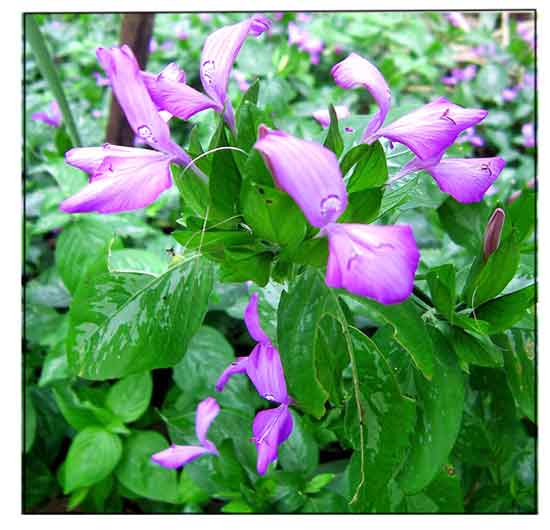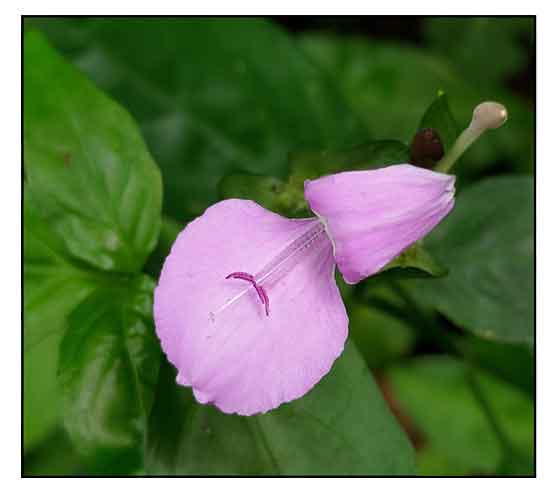 Gen info Gen info
- Dicliptera is a genus of flower plants in the bear's breeches family, Acanthaceae. It includes 223 species native to the tropics and subtropics worldwide.
-
Dicliptera tinctoria is a species of plant in the family Acanthaceae.
Botany
• Dye Foldwing is a perennial herb up to 3 ft tall. An extract of its leaves is used as a food dye, and imparts a magenta tone to some Vietnamese foods, particularly in a taro-filled cake. Flowers are borne in cymes in leaf-axils or at branch-ends, stalked. Flower-cluster-stalk is 0.3-2.3 cm; outer involucral bracteoles broadly ovate, ovate, or elliptic, unequal in size, tip pointed; larger outer involucral bracteole 2.3-3.3 x 0.8-1.5 cm; smaller outer involucral bracteole 0.71-0.85 x as long as larger one; inner cymule bracteoles triangular-subulate, 1-2 mm. Sepal-cup is 4.5-5 mm, velvet-hairy; lobes lanceshaped. Flowers are pink, 3.5-5.7 cm, outside velvet-hairy with non-glandular trichomes; tube about 1.5 mm in diameter. Lower lip broadly ovate-elliptic, 2.2-2.6 x about 1.8 cm, tip notched; upper lip oblong, 2-2.5 x about 0.9 cm, 3-lobed. Staminal filaments are about 1.3 cm. Stems are 5- or 6-angled, much branched, grooved, velvet-hairy. Leaf-stalk is u to 3.5 cm; leaf blade ovate to lanceshaped-ovate, 3-14.5 x 1.5-5.3 cm, both surfaces finely velvet-hairy or becoming hairless, secondary veins 5 or 6 on each side of midvein, base broadly wedge-shaped to nearly rounded, margin entire to sinuate, tip tapering to pointed. Capsule is about 1.5 cm, velvet-hairy. Seeds about 1.5 x 1.5 mm. (Flowers of India)
Growth form: A perennial herb, it can grow up to 1m tall. Foliage: Simple leaves are ovate to lance-shaped, 3 - 14.5cm long and 1.5 - 5.3cm wide, arranged in opposite pairs along the stem. Flowers: Flowers are borne in clusters at the tip of the stems. Each flower consists of 2 pink colored petals. The lower petal is broadly ovate-elliptic while the upper petal is oblong, narrower than the lower petal and 3-lobed. Fruit: Fruit is a club-shaped to elliptical capsule. (FLORA & FAUNA WEB)
 Distribution Distribution
- Native to the
Philippines.
- Also native to Assam, Cambodia, China South-Central, China Southeast, Hainan, Jawa, Laos, Malaya, Taiwan, Thailand, Vietnam. (1)
Constituents
- Study of Magenta leaf extract for secondary metabolites yielded alkaloid compounds, flavonoids, saponins, triterpenoids, and tannins.
(see study below) (3)
-
Qualitative phytochemical screening of aqueous extracts of Peristrophe bivalvis leaves revealed tannins ++. flavonoids ++, terpenoids ++, resins ++, phenols +, with absence of alkaloids, saponins, sterols, glycosides, and phlobatannins. Properties
- Studies have suggested nontoxic, antimicrobial, nephroprotective, antihypertensive, anticancer, phytoremediation, antioxidant, anti-venom properties.
Parts used
Leaves, stems.
 Uses Uses
Edibility / Culinary
-
Leaf extract used as natural food coloring for Vietnamese cuisine.
- Used for coloring sticky rice.
Folkloric
- No reported folkloric medicinal use in the Philippines.
- In Chinese traditional medicine, decoction of leaves used for treatment of cough, dysentery, diarrhea, and bronchitis. Poultice of pounded leaves applied to skin complaints.
- In Vietnam, the Mien people use decoction of aerial parts as blood tonic. (2)
- Used for the treatment of hypertension, painful sprains, skin diseases, tuberculosis, acute bronchitis, anti-inflammatory conditions, hepatitis, and diabetes. (7)
Others
- Dye: Extract from leaves used as food dye, which imparts a magenta tone to some Vietnamese foods, like the taro-filled cake, banh da lon, and glutinous rice dishes such as xoi la cam, a sweet desert. (2) In Indonesia, red dye extracted from leaves used to color cotton and mats. (8) The dyeing material is prepared by pounding the leaves and young stems into a pulp and drying it in the sun. A mordant may not be necessary. (16)
- Landscape: Ornamental cultivation. Also used as ground cover.
- Veterinary: In Meghalaya, India, leaves used as livestock fodder as health tonic. (14)
Studies
• Phytoconstituents / Toxicity Testing / Leaves: Study of Magenta leaf extract for secondary metabolites yielded alkaloid compounds, flavonoids, saponins, triterpenoids, and tannins. Toxicity testing in white male mice showed an LD50 value of greater than 8 g/kbw. Based on Loomis criteria, the extract is practically non-toxic. (3)
• Antimicrobial / Leaves and Stems: Study evaluated the antimicrobial activity of ethanolic extracts of leaves and stems of Peristrophe bivalvis by agar diffusion streak method, using doses of 10, 40, 70, and 100 mg. Zone of inhibition produced by the extracts compared with standard Gentamicin 10 ≤µg/ml for bacterial and Clotrimazole 25 µg/ml for fungi. Leaves showed more antimicrobial activity compared to stems. (4)
• Antioxidant / Nephroprotective / Leaves: Study evaluated the protective role of magenta leaves extract (Peristrophe vivalvis) on kidneys after being given a toxic dose of acetamiophen. Results showed administration of magenta leaves extract at dose of 250 mg/kbw can protect renal function as seen from serum creatinine levels. Analysis of tubular kidney function showed less than 60% necrosis was found in tubular cells. Nephroprotection was attributed to the flavonoids in the extract, which can trigger activation of endogenous antioxidants through activation of trancription factor, Nrf-2. (5)
• Effect on Glucose and Lipid Metabolism / Leaves: Study evaluated the effect of aqueous extract of Peristrophe bivalvis (APB) on fasting blood glucose and lipid profile in male Wistar rats pretreated with nitro-L-arginine methyl ester (L-NAME). Results showed that APB corrected the hyperlipidemia and hypoglycemia caused by L-NAME, an effect that may be due to activation of cGMP. (6)
• Antihypertensive / Leaves: Study evaluated the antihypertensive mechanism of aqueous extracts of PB leaves (APB) on L-NAME-induced hypertension in male Wistar rats. Results showed significant decrease in BP in the NAPB group. Renin, ACE, and angiotensin-II levels were significantly decreased while cGMP levels were increased. Malondialdehyde levels were significantly decreased, while SOG and GSH levels were increase. Results suggest the aqueous leaf extract of Peristrophe bivalvis reduced blood pressure via modulation of cGMP signaling pathway and the renin-angiotensin system. (7)
• Natural Dyeing Production / Leaves: In Vietnam, among food-dyeing plants, Peristrophe bivalvis is the most commonly used and widely grown to make foods look more attractive-looking. The coloration components of P. bivalvis varieties were contributed by complex compound of photosynthetic pigments, anthocyanins, and flavonoids. Study evaluated total phenolics, total flavonoids, and effect of extraction methods, dissolved solutions (water and methanol) on the contents assessed. Antioxidant screening by DPPH method showed stronger radical inhibition of organic extractions than that of aqueous extraction. Results suggest potential for using P. bivalvis varieties as natural dyeing production for food and pharmaceutical industry.
(9)
• Anticancer / Leaves and Stems: Study evaluated the invivo anticancer activity of ethanolic and aqueous extracts of leaves and stems of Peristrophe bivalvis by tryphan blue dye exclusion method and brine shrimp lethality bioassay method. Extracts were cytotoxic in a dose dependent manner, with the ethanolic extract
more potent than the aqueous extract. Leaves showed more anticancer activity as compared to stems. CT50 of EE of leaves was 175.25 µg/mL in EAC cell lines, while LC50 was 176.49 µg/mL. Results showed potential cancer prevention in a dose-dependent manner. (10)
• Safety as Colorant / Leaves: Study evaluated yellow and purple pigments extracted from Gardenia fruits and Peristrophe leaves for chemical analysis, antioxidant and toxicity tests. The major compound contributing to the purple color of the Peristrophe extract was Perisbivalvine B (C13H10N2O4). The extract also possessed antioxidant activity with IC50 if 0.31 g/L. On toxicity testing on zebrafish embryos, extract showed low toxic activity with high LD50 of 0.74 g/L. Extract showed no toxicity on mice. Results suggest the pigment extracted from Peristrophe can be safely used as food colorants. (11)
• Cytotoxicity Against Cancer Cell Lines / Pigment: Study evaluated pigment extracted from Purple Cam stems and leaves for antioxidant activity, anti-inflammatory activity, and cytotoxicity against A549 and Hep3B liver cancer in humans. Pigment extract exhibited oxidative activity with 71% inhibition, but showed no anti-inflammatory activity. At test concentration of 100 µg/ml, it was capable of killing human lung cancer cell line A549 and Hep3B liver cancer. (12)
• Phytoremediation of Cadmium Contaminated Soils: Study evaluated the ability of cadmium (Cd) accumulation in Peristrophe bivalvis cultivated in a pot experiment for 60 days at various Cd amounts of 0, 20, 60, and 100 mg/kg.
No toxic effects were observed. Presence of Cd did not inhibit growth of the plant. P. bivalvis demonstrated reduced translocation factor (TF) and bioconcentration factor (BAF) values <1. At experiment's end, enhanced Cd uptake showed maximum value of 1.56 mg/plant. Results suggest P. bivalvis had tolerance and phytostabilization ability for Cd. (13)
• Molecular Docking Activity on Non Small Cell Lung Cancer: Molecular docking activity evaluated whether peristrophine, apioside, and pelargonidin 3-sambubioside compounds could be developed as a drug for non-small cell lung cancer (NSCLC). Peristrophine, apioside, and pelargonidin 3-Sambubioside have a molecular mechanism in inhibiting ROS1 in Non-Small Cell Lung Cancer (NSCLC) through the formation of hydrogen bonds in the protein ROS1. From Lipinski's analysis, the peristrophine test compound has met the requirements and seen from the LD50 value of the peristrophine test compound, apioside and pelargonidin 3-Sambubioside has the same toxicity class as the comparison compound, namely crizotinib at class 4 toxicity.
(15)
• Anti-Snake Venom / Stems and Leaves: Study evaluated the invitro anti-snake venom potential of Peristrophe bivalvis (PB) extracts against Naja kaouthis (NK) and Trimeresurus albolabris (TA) venoms. Invitro cytotoxic and enzymatic analysis of ethanol extracts of stems and leaves showed good anti-snake venom activity against NK and TA venoms. Ethanol extract of leaves exhibited weak DPPH radical-scavenging activity. Invivo acute oral toxicity testing of ethanol whole plant extract caused no abnormal toxic signs or deaths in treated rats. (17)
Availability
- Wild-crafted.
- Cultivated for its food-coloring property.
- Dried magenta plant leaves and leaf powder in the cybermarket.
|

![]()






